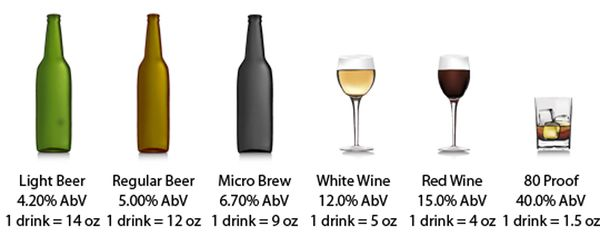Alcohol Facts
Drink Equivalencies
A standard drink is 12 ounces of beer, four ounces of wine or 1-1/4 ounces of 80 proof distilled spirits. They all contain about the same amount of pure alcohol (about 1/2 ounce). These amounts are dependent upon the percentage of alcohol by volume and many beers, wines, and spirits do not follow this standard.

| Beverage | Drink Size | Abv |
|---|---|---|
| Light Beer | 14 oz | 4.20% |
| Regular Beer | 12 oz | 5.00% |
| Micro Brew | 9 oz | 6.70% |
| White Wine | 5 oz | 12.0% |
| Red Wine | 4 oz | 15.0% |
| 80 Proof | 1.5 oz | 40.0% |
Alcohol’s Path Through the Body
About five percent of the alcohol consumed leaves the body through urine, sweat glands, and breathing. Most of the alcohol must be broken down (metabolized) by the liver to remove it from the system. The liver metabolizes alcohol at a very constant rate, approximately one drink per hour. If there is excessive alcohol in the blood, the liver cannot speed up the detoxification process. The unmetabolized alcohol just continues to circulate in the bloodstream. This is intoxication – when there is a buildup of alcohol in the system.
Allowing the liver enough time to metabolize the alcohol is the only way to remove alcohol from the body. A cold shower, fresh air, exercise, or black coffee will not help sober a person up. Time is the only thing that will remove alcohol from the system (about an hour per standard drink).
Alcohol does not require digestion. Most passes into the stomach. About 20 percent is absorbed into the bloodstream through the stomach. The other 80 percent passes into the small intestine, where absorption is faster. The pyloric valve, which separates the stomach from the small intestine, closes when food is present in the stomach (especially protein and fatty foods). Therefore, food slows intoxication.
Blood Alcohol Concentration
The amount of alcohol in the body is measured as blood alcohol concentration (BAC). A BAC of .08 percent is the equivalent of 1/8 of a drop of alcohol to 1000 drops of blood. The body is very sensitive to alcohol. A person with a BAC of .30 percent may lapse into a coma, and a BAC of .40 percent can result in death.
How can you tell what a person’s BAC is? You can’t unless you have special equipment like a Breathalyzer. ABC does not expect you to know what a person’s BAC level is, but you should rely on how a customer looks and acts to determine if you should sell alcoholic beverages to them.
| BAC percent | Effects of Increased BAC Levels on a Typical Person |
|---|---|
| .01 - .03 | No apparent effects, slight mood elevation. In California, you will test as legally impaired at .01 percent BAC if you are under 21. |
| .04 - .06 | Feeling of relaxation, sensation of warmth, minor impairment of reasoning and memory |
| .07 - .09 | Mild impairment of balance, speech, vision, and control. In California, you will test as legally impaired at .08 percent BAC if you are over 21. |
| .10 - .12 | Significant impairment of motor coordination and loss of judgment, speech may be slurred |
| .13 - .15 | Gross impairment of motor control, blurred vision and major loss of balance, onset of dysphoria (anxiety, restlessness) |
| .16 - .20 | Dysphoria predominates, nausea may appear, drinker has the appearance of “sloppy drunk” |
| .25 - .30 | Severe intoxication, needs assistance walking, mental confusion, dysphoria with nausea and some vomiting |
| .35 - .40 | Loss of consciousness, brink of coma |
| .40 & up | Onset of coma, likelihood of death due to respiratory failure |
Alcohol’s Effects on the Body
Alcohol is a depressant drug. Despite the initial feeling of energy it gives, alcohol affects judgment and inhibitions while slowing reaction times.
Alcohol also depletes the body’s fluids and can cause a person to feel thirst. As a result, someone drinking may continue to drink more.
Alcohol causes the small blood vessels on the surface of the skin to dilate. This result is the loss of body heat. The drinker feels like they are getting warm, but in fact the body is chilling.
Normally, the liver maintains the body’s blood sugar levels, but when alcohol is present, the liver metabolizes alcohol before its other functions. Diabetics are not the only persons who need to be aware of this disruption in blood sugar levels. To the average person, effects after alcohol has entered the bloodstream may be hunger, nausea, and hangovers, which are all caused by a drop in the blood sugar level.
Factors Affecting Intoxication
Alcohol affects each person differently. It also affects the same person differently on different occasions.
The following are some of the factors that affect how quickly a person will become intoxicated:
Gender – Alcohol affects men and women differently. In some women, the effects of alcohol tend to be stronger and last longer. This may be due to women having higher levels of estrogen, body fat, and lower levels of body water than men. All of which limits the amount of alcohol absorbed into tissues, thus remaining in the bloodstream. Men, on the other hand, typically have more of the enzymes that break down alcohol in the stomach before being absorbed into their bloodstream.
Mood – Alcohol exaggerates the mood of a person. An individual who is depressed may become severely depressed while drinking. People who are fatigued or stressed become intoxicated more quickly than people who are rested and relaxed. Physical, mental, or emotional exhaustion will increase the impairment caused by alcohol.
Food in the stomach – Food slows down the rate of intoxication because food causes the pyloric valve at the bottom of the stomach to close while digestion takes place. This keeps alcohol from entering the small intestine, where most of it is absorbed. The best foods for slowing intoxication are greasy, high-protein and fatty foods because they are more difficult to digest and stay in the stomach longer. For example: meat balls, chicken wings, cheese, pizza, dips, fried foods, nachos, and beef tacos.
Amount of alcohol consumed – The more alcohol a person consumes, the more it accumulates in the blood, increasing intoxication. The liver can only get rid of about one drink per hour.
Speed of consumption – A person who drinks rapidly or gulps drinks becomes intoxicated faster than a person who sips or drinks slowly because they ingest a larger amount of alcohol over the same period.
Tolerance to alcohol – Tolerance is the body’s ability to adapt to toxic substances like alcohol. Tolerance varies from person to person, but some have a naturally high tolerance, while others may develop high tolerance through habitual drinking. A person with a high tolerance may appear sober to others when they are extremely impaired.
Physical condition – A person who is out of shape becomes intoxicated more quickly than a person who is muscular. Fat does not absorb blood, water, or alcohol, while muscle does.
Medication/Drugs – Mixing alcohol and medications/drugs together can lead to serious physical, behavioral, and health complications. Not only can alcohol and drugs increase the effects of each substance, they can also trigger dangerous interactions. The side effects of combining alcohol with drugs may range from mere discomfort to life-threatening reactions. Alcohol should not be sold to a person who has taken any drug.
Carbonation – Carbonated alcoholic drinks increase the rate of alcohol absorption. This is because the pressure inside the stomach and small intestine force the alcohol to be absorbed more quickly into the bloodstream. Sugars and juices mixed with alcohol also speed up the absorption rate.
Altitude – Drinks consumed at high altitudes are nearly twice as potent in their effect for the first few days until the person becomes accustomed to the elevation.
Contact
Additional information may be obtained by contacting:
Alcoholic Beverage Control
3927 Lennane Drive, Suite 100
Sacramento, CA 95834
Email us at headquarters@abc.ca.gov
Call (916) 419-2500



